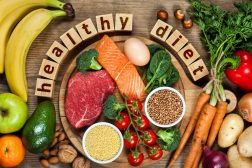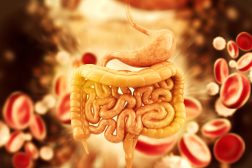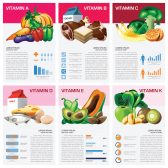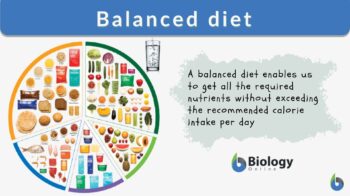
Balanced diet n., [ˈbælənst ˈdaɪət] Definition: balanced amounts in proper proportions of carbohydrates, fats, proteins, vitamins, minerals, and water intake.
Table of Contents
What is a balanced diet?
What is the definition of a balanced diet? A nutritionally balanced diet fulfills all nutritional needs of the body. Each body needs a specific amount of nutrients and calories to stay active and healthy. A good diet enables us to get all the required nutrients without exceeding the recommended calorie intake per day. Avoiding junk food as well as foods with low nutritional value is a part of a balanced diet. The food pyramid may not be recommended in some places. Nutritionists recommend establishing a balanced diet by getting nutrients from five major groups of food instead. According to the most recent recommendations, an example of a balanced diet is a balanced meal including vegetables and fruits that must form about half of the human’s plate serving since vegetables and fruits are the healthiest foods to eat. The rest of the food plate serving should contain proteins and grains. Moreover, balanced meals should be accompanied by a small serving of dairy with low-fat content or a source of nutrients in dairy products. Examples of nutrients of a balanced diet include the right proportions of minerals, vitamins, carbohydrates, fats, proteins, and water intake.
Calories in foods represent the energy stored in that food. The human body uses calories to perform daily activities such as breathing, moving, thinking, walking, and other vital functions. The average amount of calories needed for a person is about 2000 calories per day to maintain their current weight. However, the daily calorie requirement varies according to the person’s sex, age, and level of physical activity. For example, men usually need more calories than women.
Empty calories are found in food providing large amounts of calories without having a good nutritional value. Examples of empty calories foods are soda and energy drinks, cookies and cakes, fries and chips, pizza, ice cream, and processed meat. Therefore, the consumption of foods with empty calories should be limited in order to maintain a healthy life.
In conclusion, what is a healthy diet? A healthy balanced diet should contain different vegetables and fruits every day, starchy food with higher fiber like bread, dairy products or their alternatives, proteins such as meat, fish, beans, or eggs, small amounts of unsaturated fats, and about 6 to 8 glasses of fluids.
To get different nutrients, you should eat the healthiest foods while avoiding foods with added sugars, foods with high salt content, saturated fats, and processed food.
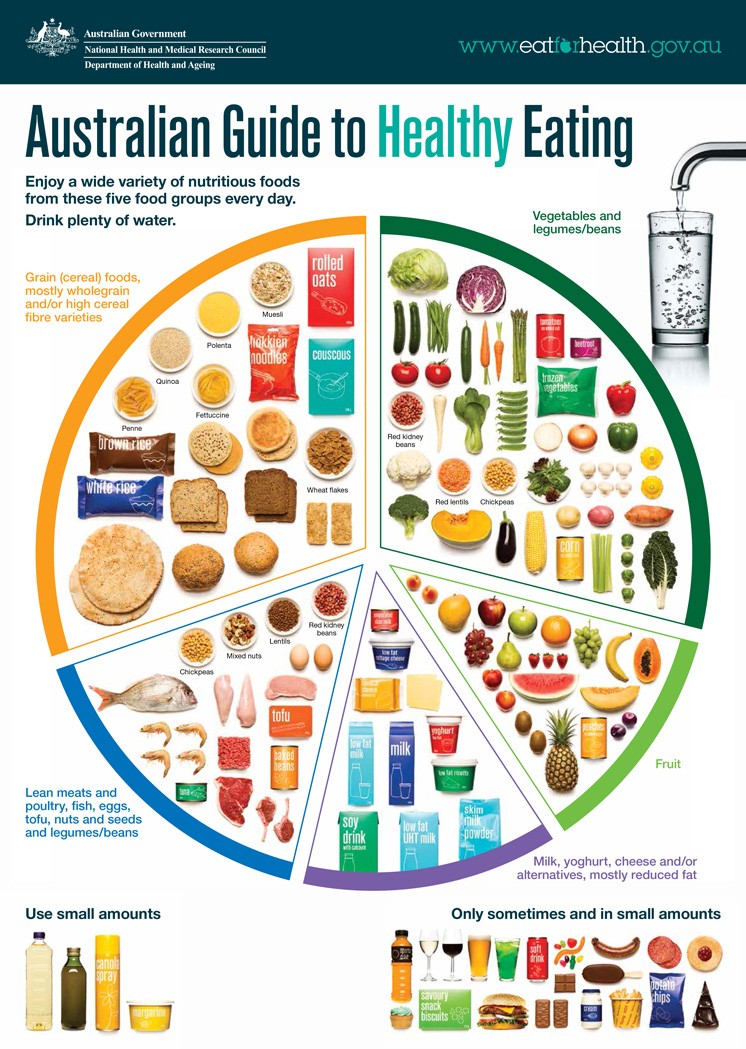
Balanced diet is a diet consisting of adequate amounts of all the necessary nutrients recommended for healthy growth and for efficient daily activities and functions. A balanced diet contains the proper quantities and proportions of the needed nutrients to maintain good health. It must have balanced amounts in proper proportions of carbohydrates, fats, proteins, vitamins, minerals, and water intake.
Importance of a balanced diet
Why is it important to eat healthily? A well-balanced diet provides the human body with essential nutrients needed to allow the body to effectively perform different activities. Without balanced nutrition, the body is more susceptible to fatigue, infections, diseases, and reduced activity. On the other hand, children should have a balanced diet containing different nutrients in order to avoid impaired development and growth, different infections, and low academic performance. Children who do not consume enough healthy foods are most likely to develop persistent unhealthy eating habits into adulthood. Moreover, overweight children have a higher risk of developing heart disease, type 2 diabetes, and cancer in their adulthood.
Eating well ensures proper nutrition that keeps the body active and healthy. A healthy proper diet protects the body against noncommunicable diseases. such as heart disease, stroke, cancer, and diabetes that are the most common leading causes of death in the United States. It also protects the body against malnutrition.
Lack of physical activities and an unbalanced diet are global health risks. In order to avoid weight gain, calorie intake should be balanced, the intake of saturated fats should be minimized, and decrease salt intake. Increased intake of saturated fats elevates blood cholesterol levels and eventually increases the risk of heart disease development.
Eating and drinking large amounts of sugars increase the risk of tooth decay and obesity. Too much salt may increase blood pressure, which consequently increases the risk of developing a stroke or heart disease.
The 5 food groups
What are the food groups? A balanced diet plan should include all daily nutritional requirements from five groups of food; they are vegetables, fruits, grains, protein, and dairy. Different groups of food provide us with the needed calories to do our daily activities. However, consuming calories more than the body needs will eventually lead to unhealthy weight gain because extra calories are not consumed but stored in the body as fats. The total calorie intake should include less than 10% of it from free sugars added to foods or drinks. But how much fat per day? fats should represent less than 30% of the total intake of energy as you should have a low-fat diet.
Fats are found as unsaturated recommended fats in nuts, sunflower, fish, olive oils, avocado, and soybean, whereas saturated fats are not recommended and can be found in coconut oil, butter, fatty meat, and cheese. The intake of saturated fat per day should be limited to about 5% of total calories. Trans-fats are found in all pre-packed snacks such as biscuits, fried foods, cookies, pies, and pizza. Trans-fats are industrially produced; therefore, their intake should be avoided.
Each food group provides the body with different nutrients; therefore, we should include foods from all five groups in our daily food intake to make sure we get the full range of nutrients needed for our bodies to effectively function and stay healthy. Consequently, excluding one or more food groups will negatively affect the body. For example, cutting starchy carbohydrates may decrease the intake of B vitamins and dietary fiber.
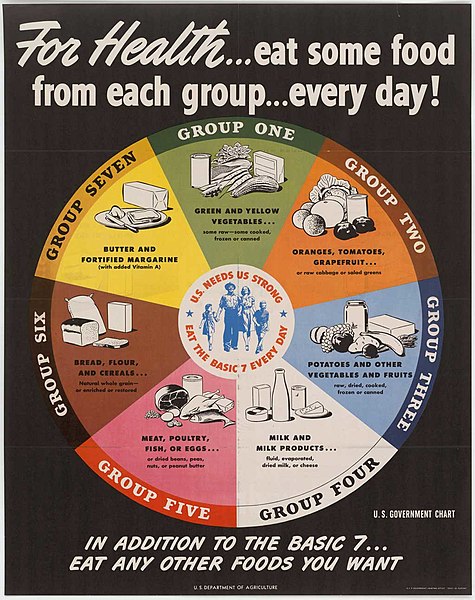
Vegetables
Vegetables are rich in essential vitamins, minerals, fiber, and antioxidants. Vegetables should be consumed daily in order to get enough daily nutrition. There is a variety of vegetables such as orange or red vegetables, legumes like peas and beans, leafy greens such as broccoli and spinach, starchy vegetables like potatoes, and other vegetables. Vegetables from each of these five subgroups should be eaten every week to get different nutrients. Vegetables may be eaten as raw or cooked food. However, some of the cooked vegetables’ nutritional value is lost, also, some cooking methods might be unhealthy such as deep frying. Vegetables should make up over a third of the daily food intake. They can be used as a side dish, roasted, salad, soup base, or in smoothies and juices. Consuming adequate amounts of vegetables and fruits protect the body from cancers, strokes, and heart disease.
Fruits
Plenty of fruits should be included in a balanced diet. Fruits are tasty. They can provide a satisfying dessert or snack since they are rich in natural sugars. Fruits, as well as vegetables, are rich in a variety of essential vitamins, minerals, fiber, and antioxidants. It is recommended to eat whole fruit instead of drinking fruit juice. Juices do not contain fiber or the full range of nutrients in the whole fruit. Also, during the manufacturing of fruits sugars are added, which are considered empty calories. Moreover, frozen or canned fruits should be canned in water, not syrups to avoid empty calories. Fresh local fruits provide a greater range of nutrients than frozen or canned fruits.
Grains
There are two types of grains: whole and refined grains. Whole grains include the endosperm, germ, and bran of the grain. When eaten, the body slowly breaks down different components of the grain so it has less impact on blood sugar. Moreover, whole grains contain more protein and fiber than processed refined grains. Refined grains may cause spikes of blood sugar because they do not contain the natural components found in whole grains including the outer shell, which are removed during processing.
A balanced diet recommendation states that grains should constitute about a quarter of the plate. Additionally, half of the consumed grains should be healthy whole grains such as oats, barley, wholewheat pasta, and brown rice. Refined grains such as white flour are used in many foods like bread and baked foods. Therefore, try to eat whole grains instead of white rice, bread, and pasta.
Protein
Dietary proteins are essential in a balanced diet. It is suggested that proteins should form about a quarter of the plate. Proteins are essential for maintaining muscle mass, development of muscles, growth, wound healing, and other important functions. Animal and plant-based proteins are the main examples of nutrients high in proteins. Animal meats are good sources of protein including red meats such as beef, poultry like turkey, chicken, and fish including sardine and salmon. Processed meat contains added salts and preservatives, therefore, unprocessed meat is a healthier option. Plant-based proteins found in legumes, nuts, soy products, and beans are good alternative sources of proteins. However, meat is not only a source of proteins but is a good source of other essential nutrients like zinc, iron, vitamin B12, as well as other vitamins and minerals. You should ensure protein intake every day. Meats should be cooked thoroughly to avoid any source of contamination.
Dairy
Dairy products are the main source of calcium that is essential to maintain healthy bones. It is recommended to consume low-fat dairy and soy products like yogurt, low-fat milk, soy milk, and cottage cheese. Lactose-intolerant people can get calcium from other sources such as soy-based products or lactose-free products. Dairy products also provide a variety of nutrients including vitamin D, proteins, and calcium. People following a vegan diet can consume alternatives of dairy products like oats, coconut, flaxseed, almond, and soy-based milk.
Losing weight
A balanced diet can help people reduce their weight especially if it is accompanied by regular exercise or an active lifestyle. A balanced diet with ideal nutrition helps people to lose weight by avoiding processed food and excessive carbohydrates, increasing protein intake, increasing minerals, vitamins, fiber, and nutrients consumption, avoiding trans-fats and limiting saturated daily fat intake, refined grains, and added salts and sugars. Weight loss can be enhanced by adding simple daily activities such as walking for 30 minutes, taking the stairs, or doing cardio exercises.

How to define healthy food? Healthy food is food containing adequate amounts of essential nutrients recommended for efficient functioning. The best diet plan is the healthy eating plan where the daily nutrition is perfectly balanced as all things should be included in the daily food intake with the proper amounts. Best foods for weight loss are foods containing high content of proteins such as tuna, salmon, and eggs, or green vegetables and legumes.
How to eat healthily? Eating healthy provides good nutrition. The best diet is the diet through balancing the selection of different foods from the 5 groups. Healthy meals include vegetables, fruits, grains, proteins, and dairy whenever possible. Healthy diet foods comprise low-fat content, low added sugars, and low amounts of salt.
READ: A Balanced Diet: Vitamins A – K, Minerals and Proteins, and Carbohydrates and Fat
Try to answer the quiz below to check what you have learned so far about a balanced diet.
References
- AHA. (n.d.). Saturated Fat. www.heart.org. https://www.heart.org/en/healthy-living/healthy-eating/eat-smart/fats/saturated-fats.
- Balanced diet. Nutritionist Resource. (n.d.). https://www.nutritionist-resource.org.uk/articles/balanced-diet.html.
- Cox, O. (2017, May 1). Australian Guide to Healthy Eating. Eat For Health. https://www.eatforhealth.gov.au/guidelines/australian-guide-healthy-eating.
- Healthdirect Australia. (n.d.). A balanced diet. healthdirect. https://www.healthdirect.gov.au/balanced-diet.
- A healthy, balanced diet. British Nutrition Foundation. (n.d.). https://www.nutrition.org.uk/healthyliving/healthydiet/healthybalanceddiet.html?limitstart=0.
- Krans, B. (2020, June 29). Balanced Diet. healthline.com. https://www.healthline.com/health/balanced-diet#what-is-it.
- NHS. (2019, March 27). Eat well. NHS Choices. https://www.nhs.uk/live-well/eat-well/.
- World Health Organization. (n.d.). Healthy diet. World Health Organization. https://www.who.int/initiatives/behealthy/healthy-diet.
- World Health Organization. (n.d.). Healthy diet. World Health Organization. https://www.who.int/news-room/fact-sheets/detail/healthy-diet.
©BiologyOnline.com. Content provided and moderated by Biology Online Editors.

